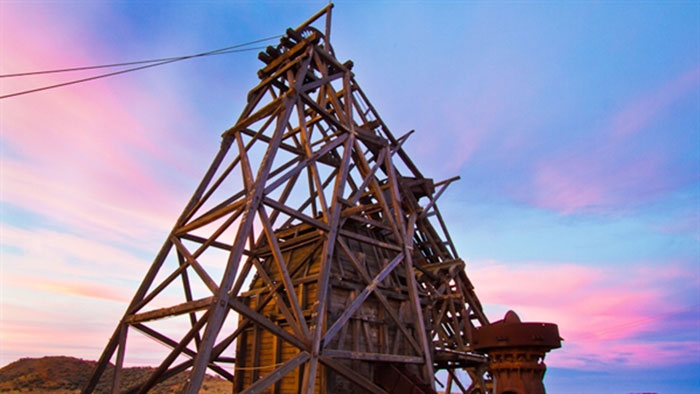Gwalia Historical Collections
The Gwalia collection represents mining activities at the Sons of Gwalia Mine (1896-1963), commercial and domestic life in Gwalia and Leonora, and pastoralism in the surrounding area since 1896.
The collection consists of extant buildings and structures from the Sons of Gwalia Mine and Gwalia community as well as objects (including documents, books, textiles, photographs, artwork, machinery, equipment and furniture) related to these buildings and structures and the people associated with them. The collection also includes items relating to towns, settlements and activities within the Shire of Leonora.
Objects evoke the mining technology of the past and commemorate landmark events in the life of the region.The collection tells the stories of hardship in a remote mining community and the ingenuity of the inhabitants to make do with what was available in order to survive.
Click on a thumbnail to view a slideshow of all of the images in this gallery.
Large Objects
Timber Incline Headframe
 The headframe is the only surviving large timber incline headframe in Australia and one of very few timber headframes of any size from the 19th century still in existence world-wide.
The headframe is the only surviving large timber incline headframe in Australia and one of very few timber headframes of any size from the 19th century still in existence world-wide.
- The main structure of the timber incline headframe was built between 1896 and 1898. Substantial extensions were made in 1912 with the installation of the steam winder.
- Internal sections associated with the tipping of skips, separation of fine and coarse ore, chutes and primary crushing facilities were modified several times during the operation of the mine to suit changing mining techniques, crushing and treatment plant facilities.
Steam Winder
The 1912 Fraser and Chalmers winder is the largest of its type in Australia and one of only three remaining in the world.
- The 1912 Fraser and Chalmers steam-driven winder is complete and is an impressive example of winding technology of that era.
- The winder, which during its working years lowered thousands of men into the mine to start their daily shift, is of high cultural significance.
- The imposing winder and steam cylinders are positioned on substantial concrete and brick foundations.
Passenger Tram
- The first passenger tram in regional Western Australia ran between Leonora and Gwalia from 1903 to 1921.
- The Leonora Municipal Council purchased the private tramway and established a service between Leonora's Federal Theatre and Gwalia's State Hotel and railway siding.
Woodline Train Enigne
- Staff on the Sons of Gwalia Mine suggested that the locomotive be named ‘Ken’. The nickname was derived from the first letters of surnames of each of the three Sons of Gwalia directors – Kluge, Edquist and Newman.
- Soon after its arrival at the mine, the train engine was renamed ‘Midland’, consistent with company tradition of naming its locomotives after the places in which they were built. ‘Midland’ replaced the name ‘Ken’ on the sides of the locomotive.
- ‘Midland’ is one of three steam engines that worked on the Woodlines (rail lines to timber-cutting settlements), supplying the Sons of Gwalia mine with timber and fuel.
Mine Level Model
The timber, brass and glass mine level model, constructed in London circa 1938, is the only remaining mine model depicting the workings of the Sons of Gwalia Mine. The model comprises thirty-four horizontal glass panels with hand painted lettering, each depicting an underground level of workings of the Sons of Gwalia Mine.
Click on a thumbnail to view a slideshow of all of the images in this gallery.
Small Objects
Objects in the Mine Office depict community, cultural and mining life from the late 19th century until the middle of the 20th century. The collection, which also features the heritage of Afghan, Italian and Yugoslav migrants, tells the stories of hardship in a remote mining community and the ingenuity of the inhabitants to make do with what was available in order to survive. Objects depict the mining technology of the past and illustrate events in the life of the region.
The introduction of mining had a dramatic impact on the Aboriginal people of the Northern Goldfields. From the 1920s, the Sons of Gwalia Mine employed a few Aboriginal men to work below and above ground.
Gwalia Museum holds a small collection of Aboriginal boomerangs and spears which, together with photographs, give a glimpse into Aboriginal culture in the Leonora-Gwalia area. Today Wongi and Ngalia people live in Gwalia and Leonora, in Koara Country.
The collection includes:
- Examples of equipment adapted to the harsh Goldfields conditions by people who used available materials to construct wheelbarrows and household utensils.
- Homemade household utensils made from metal, such as a spoon and fork joined together with a screw, a corrugated iron washboard on a wooden frame and a dust pan made of metal.
- Mining items such as a hook for hoisting helmets, boots and belts in and out of the mine, miners’ carbide lamps and the wooden pattern moulds used to make machinery for the mine.
- The small collection of Aboriginal artefacts including boomerangs and spears help tell the story of the Wongutha people.
- Crockery and tableware once used at the State Hotel.
- A commemorative hammer with wooden handle and chrome head which was presented to Mr A.F. Cleland, the Mayor of Leonora, by the State Minister of Transport R.J. O’Connor at the opening the standard gauge railway line from Kalgoorlie to Leonora on 13 September 1974.
- The wheels from the water cart used to carry water to the single men’s camps, which are reinforced with timber to make them last on the rough ground.
- The mangle from Mrs Patroni’s boarding house, as well as a number of items in the museum's collection of objects from the abandoned cottages in Gwalia.
Click on a thumbnail to view a slideshow of all of the images in this gallery.